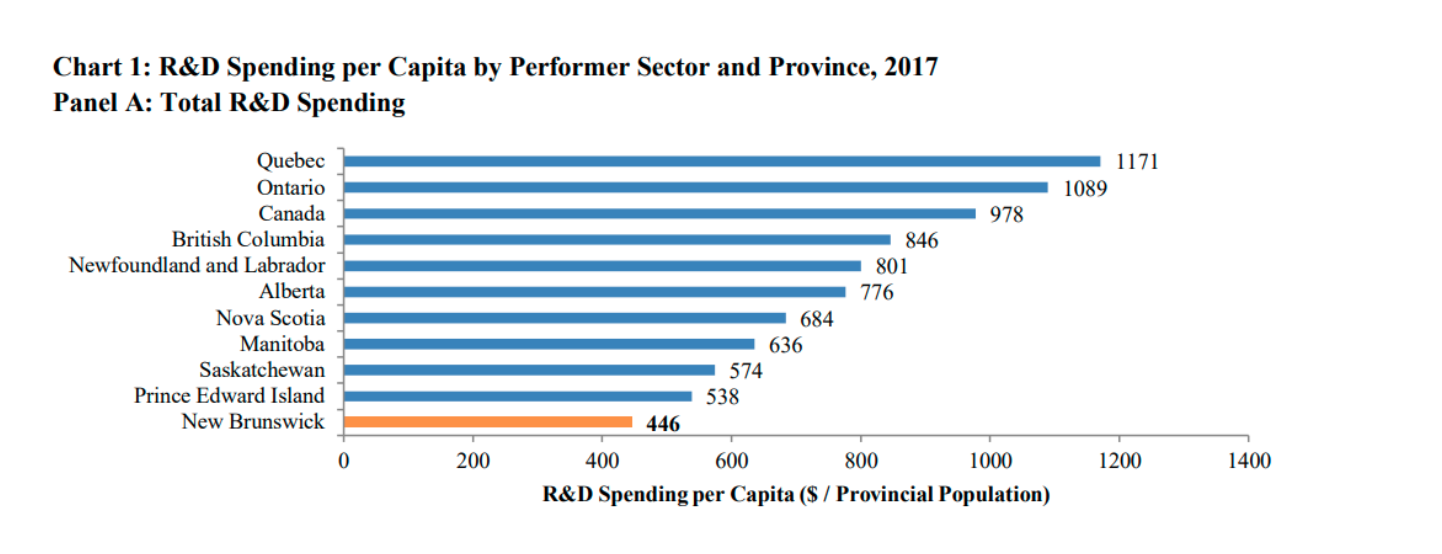Innovation plays an important role in improving productivity. Strong innovation leads to technological advancement and the creation and diffusion of new knowledge in firms, resulting in higher productivity and economic growth.
The Centre for the Study of Living Standards (CSLS) recently released a report titled “Innovation in New Brunswick” as part of a research project on the linkages between innovation and productivity in New Brunswick, prepared for the JDI Roundtable on Manufacturing Competitiveness.
The report examined seven indicators of innovation: R&D spending, R&D personnel, patents, firm-based innovation statistics, non-residential fixed investment, investment in intellectual property products, and business entry.
Overall, New Brunswick ranked low among the provinces and below the national average for all seven innovation indicators. Despite its weak performance among the provinces, New Brunswick’s innovation situation has generally improved over time in absolute terms and relative to the Canadian average.
Key statistics from the report:
New Brunswick had $342 million (in current prices) or $446 per capita in total R&D expenditures in 2017, ranking last among the provinces. The province relied mostly on the government and higher education sectors to perform R&D. The good news is: New Brunswick’s R&D expenditures increased 144 per cent from $125 million in 1981 to $304 million in 2017 (in constant 2012 dollars). This increase was largely driven by significant improvements in the business and higher education sectors (485 per cent and 448 per cent increases, respectively).
In 2017, New Brunswick’s gross entry rate was 12.0 per cent of total active firms, ranking ninth in Canada, while the province’s net entry rate was 0.2 per cent of total active firms, ranking eighth. Manufacturing had a negative net entry rate at -2.1%. This means manufacturing firms are leaving the province or shutting down at a faster rate than new firms are starting up. But there is cause for hope: among the four regions in Canada, Atlantic Canada experienced the greatest improvement in the share of innovative firms. The share of innovative firms increased by 23.3 percentage points from 45.8 per cent of total firms in the 2010-2012 period to 69.1 per cent in 2015-2017 period.
Between 2015 and 2017, 69.1 per cent of firms in Atlantic Canada were innovative, the smallest share of all the regions in Canada. Similarly, firms in Atlantic Canada were the least likely compared to those in other regions to implement any type of innovation (product, process, organizational, marketing) or to use any advanced technology.

Barriers to Innovation
New Brunswick faces several barriers to innovation, which likely explain the province’s relatively weak level of innovation. These barriers include financial issues, labour shortage issues, and a lack of motivation among firms to innovate. Based on evidence from the statistical analysis as well as a literature review of previous studies, the report identifies the following eight barriers to innovation in New Brunswick:
What does this mean for manufacturing competitiveness?
The fact that manufacturing firms are ceasing operations in New Brunswick faster than new firms are setting up should be a cause for concern. Are these exits the result of firms shutting down because they are unable to compete, or are firms relocating elsewhere because it’s tough for them to be competitive conducting operations in New Brunswick? Likely both.
The province’s relatively poor performance across the innovation indicators suggests firms could be doing more to remain competitive – if manufacturers were doing all they could to upgrade their technology and processes, maybe more of them would be scaling operations in New Brunswick instead of leaving. But this is only part of the picture – what is the province doing to ensure private sector innovation is encouraged? One key factor would be a policy environment that is competitive and stable for businesses considering whether they should commit to maintaining/expanding operations in the province long term.
If policymakers want to improve the innovation environment and improve the competitiveness of our exporters, addressing the barriers to innovation cited above would be a good start.
The full report is available for viewing.
Dr. Sarah McRae is a postdoctoral fellow at the University of New Brunswick and a member of the JDI Roundtable research team.
Return to September 2020 Newsletter
The JDI Roundtable on Manufacturing Competitiveness in New Brunswick is an independent research program made possible through the generosity of J.D. Irving, Ltd. The funding supports arms-length research conducted at UNB.